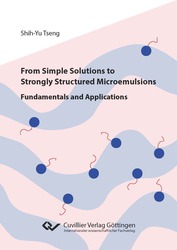| Departments | |
|---|---|
| Book Series (96) |
1378
|
| Nachhaltigkeit |
3
|
| Gesundheitswesen |
1
|
| Humanities |
2364
|
| Natural Sciences |
5406
|
| Mathematics | 229 |
| Informatics | 319 |
| Physics | 980 |
| Chemistry | 1363 |
| Geosciences | 131 |
| Human medicine | 243 |
| Stomatology | 10 |
| Veterinary medicine | 108 |
| Pharmacy | 147 |
| Biology | 835 |
| Biochemistry, molecular biology, gene technology | 121 |
| Biophysics | 25 |
| Domestic and nutritional science | 45 |
| Agricultural science | 1004 |
| Forest science | 201 |
| Horticultural science | 20 |
| Environmental research, ecology and landscape conservation | 148 |
| Engineering |
1793
|
| Common |
98
|
|
Leitlinien Unfallchirurgie
5. Auflage bestellen |
|
Advanced Search
From Simple Solutions to Strongly Structured Microemulsions (English shop)
Fundamentals and Applications
Shih-Yu Tseng (Author)Preview
Extract, PDF (470 KB)
Table of Contents, PDF (130 KB)
Microemulsions are known for their versatile properties widely utilized in fundamental research and industrial applications. They are thermodynamically stable mixtures structured on a colloidal length scale with an amphiphilic film separating water- and oil-rich domains. However, recent studies claim the existence of “surfactant-free microemulsions,” which exhibit structures on a molecular length scale. By means of systematic phase behavior and scattering experiments, this dissertation provides deep insights into the pathway from simple solutions to weakly and strongly structured microemulsions. With bulk-contrast SANS, the scattering behavior of a simple solution system made of water, cyclohexane, 1- and 2-propanol was found to be dominated by critical composition fluctuations (Ornstein-Zernike). Further analysis of critical phenomena revealed the critical exponent doubling that follows the scaling law γ ~ “2” ν. On the other hand, weak scattering signals described with a new model were detected in the film-contrast SANS data due to the nearby tricritical point (TCP). After crossing the TCP, the formation of well-defined amphiphilic films was demonstrated by increasing the amphiphilicity of the amphiphile. Subsequently, the influence of modifications of the amphiphilic film by adding novel diblock polymers was studied. As a result, enhanced efficiency and strengthened structural ordering were achieved in typical alkane microemulsions and novel CO2 microemulsions. Finally, the properties of industry-relevant microemulsions were investigated in two application-oriented projects. One project focused on the phase behavior and the microstructure of polyol-rich CO2 microemulsions, which can be used for the polyurethane (PU) foam production with cell sizes of a few micrometers. The other project focused on the formulation of optimum microemulsions stabilized by highly efficient extended surfactants. The experimental parameters from phase behavior studies helped determine the coefficients of the HLD equation, which can serve as a prediction tool for tackling a wide variety of formulation problems. Above all, this doctoral dissertation elucidated the pathway toward structured microemulsions and demonstrated versatile aspects of microemulsions’ applications.
| ISBN-13 (Hard Copy) | 9783736977112 |
| ISBN-13 (eBook) | 9783736967113 |
| Final Book Format | A5 |
| Language | English |
| Page Number | 244 |
| Lamination of Cover | matt |
| Edition | 1. |
| Publication Place | Göttingen |
| Place of Dissertation | Stuttgart |
| Publication Date | 2022-12-12 |
| General Categorization | Dissertation |
| Departments |
Chemistry
Physical chemistry |
| Keywords | simple solutions, einfache Mischungen, structured microemulsions, strukturierte Mikroemulsionen, surfactant-free microemulsions, tensidfreie Mikroemulsionen, composition fluctuations, Konzentrationsfluktuationen, critical phenomena, kritische Phänomene, critical exponent doubling, Verdoppelung der kritischen Exponenten, scaling law, Skalierungsgesetz, Ornstein-Zernike, tricritical point, trikritischer Punkt, TCP, efficiency boosting effect, polycarbonate diblock polymer, Polycarbonat-Diblockpolymer, CO₂ microemulsions, CO₂-Mikroemulsionen, polyurethane foam, Polyurethan-Schaum, PU, POSME, Salager equation, Salager-Gleichung, balanced microemulsion, extended surfactant, hydrophilic-lipophilic difference, HLD, enhanced oil recovery, EOR, small-angle neutron scattering, SANS, SWAXS, bicontinuous, Teubner-Strey |
| URL to External Homepage | https://www.ipc.uni-stuttgart.de/ |








